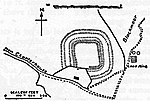Blagdon railway station
Disused railway stations in SomersetFormer Great Western Railway stationsPages with no open date in Infobox stationRailway stations in Great Britain closed in 1931Railway stations in Great Britain opened in 1901 ... and 1 more
Use British English from July 2020

Blagdon railway station is a closed terminus railway station situated in the village of Blagdon in North Somerset, England. The station opened on the 4 December 1901 when the Wrington Vale Light Railway opened the line from Congresbury.The station closed to passengers on 14 September 1931.Despite the station being closed for passengers it was host to a GWR camp coach from 1935 to 1939. Camp coach occupants were transported to the station on the daily goods train from Yatton.The station closed to goods on 1 November 1950. The site is now a private house.
Excerpt from the Wikipedia article Blagdon railway station (License: CC BY-SA 3.0, Authors, Images).Blagdon railway station
Station Road,
Geographical coordinates (GPS) Address Nearby Places Show on map
Geographical coordinates (GPS)
| Latitude | Longitude |
|---|---|
| N 51.3333 ° | E -2.7133 ° |
Address
Station Road
Station Road
BS40 7TB
England, United Kingdom
Open on Google Maps










